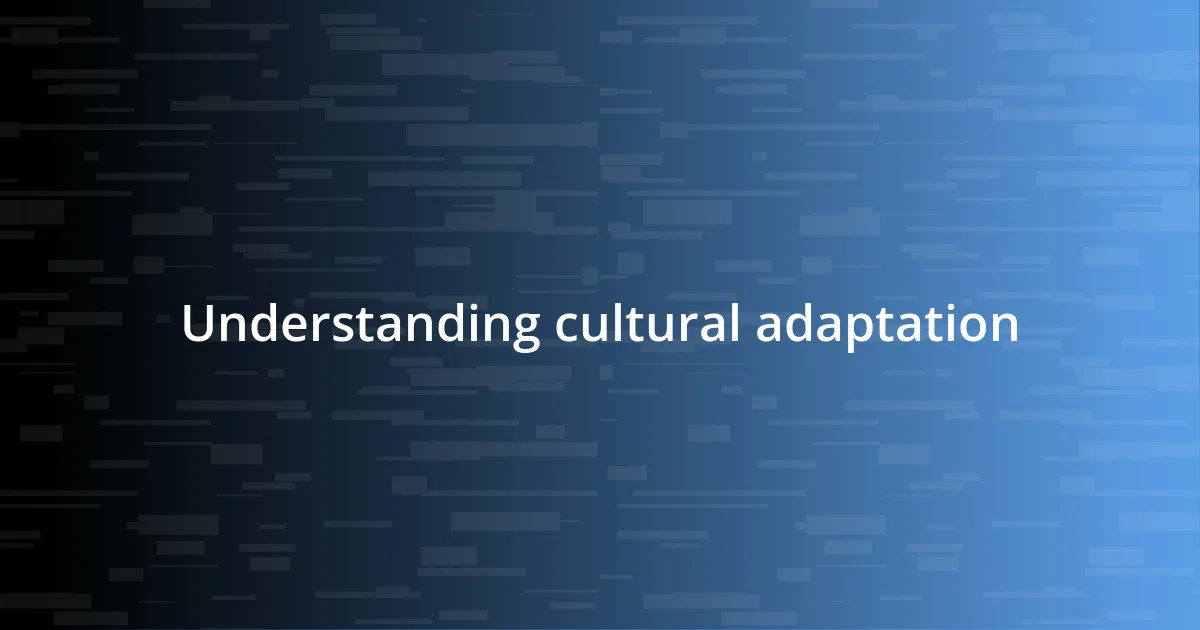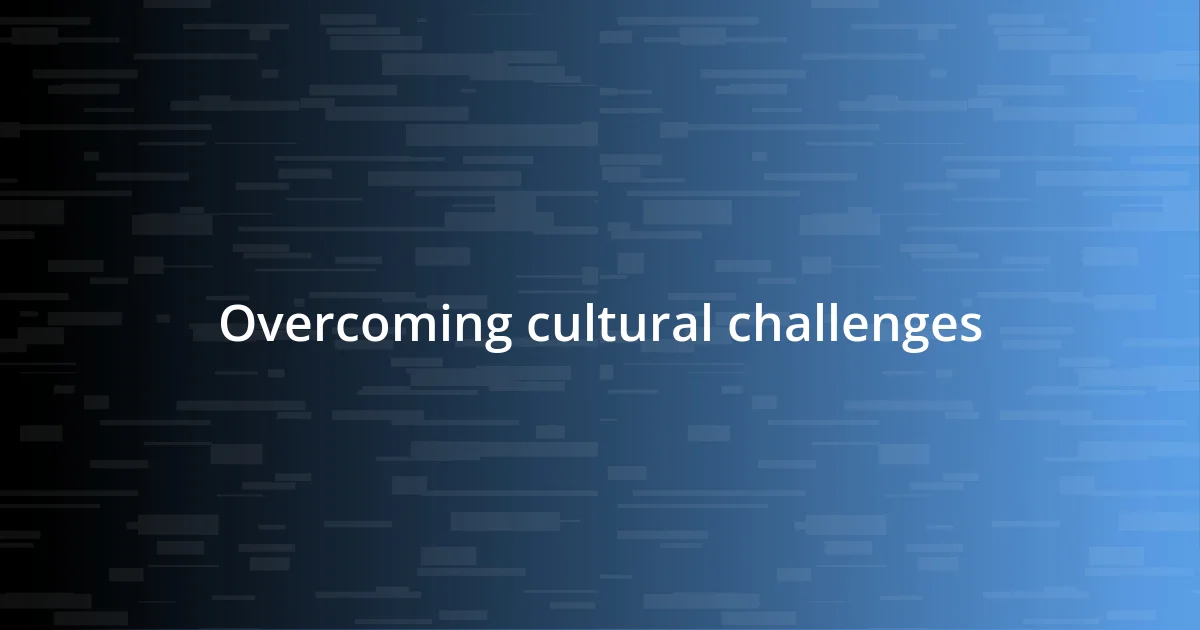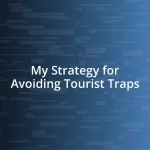Key takeaways:
- Cultural adaptation involves understanding community values, engaging in active listening, and building relationships to connect with the local culture.
- Learning the local language enhances interaction, facilitates immersion, and opens up opportunities for deeper connections through everyday conversations and cultural exchanges.
- Embracing new experiences, maintaining a flexible mindset, and being open to vulnerability allow for genuine integration into a community and foster personal growth.

Understanding cultural adaptation
Cultural adaptation isn’t just about adjusting your behavior; it often involves a deeper understanding of values and norms that shape a community. I remember when I first arrived in a new city, feeling lost amid unfamiliar customs. Have you ever felt that overwhelming sense of being an outsider? It’s a mix of confusion and curiosity that pushes you to explore and learn.
One key to adapting lies in active listening and observation. I found that absorbing the nuances of conversations and the unspoken rules around me helped me connect with the local culture. It’s interesting how something as simple as watching how people greet each other can reveal layers of meaning and context. Have you ever noticed how a smile can bridge gaps that language sometimes can’t?
Building relationships within the new culture also made a significant difference for me. I tried attending local events, which was both daunting and exciting. At first, I felt shy, but then I learned that sharing laughter and stories over a meal can dissolve the barriers of unfamiliarity. What about you? Have you found moments where a simple interaction turned into a profound connection? These experiences not only enriched my understanding but also grounded me in a community that initially felt foreign.

Building cultural awareness
Building cultural awareness starts with recognizing that each culture has its own language of gestures and traditions. I vividly recall attending a friend’s family gathering in their culture, where the warmth of hospitality took me by surprise. I learned that understanding the meaning behind certain rituals was just as crucial as the actions themselves. Have you ever sat at a dinner table and felt the weight of unspoken customs surrounding you? It can be both intimidating and enlightening.
Another important aspect is the willingness to ask questions. I’ve had moments where I shyly approached someone to inquire about a particular custom or phrase, only to receive a warm smile and a wealth of knowledge in return. This openness leads to genuine connections and fosters a deeper appreciation of cultural differences. Have you ever noticed how curiosity can break down barriers and lead to unexpected friendships?
Lastly, participating in cultural exchanges, whether through art, music, or food, has been eye-opening. I remember a small event where I got to share my traditional dishes while tasting others. It was not just about the food; it was the stories and memories we exchanged that created an enriching experience. Engaging in these activities makes the different aspects of a culture come alive, wouldn’t you agree? Building this awareness is a journey that helps to create lasting bonds.
| Aspect | Description |
|---|---|
| Understanding Rituals | Recognizing the deeper significance behind actions in a culture fosters genuine appreciation. |
| Curiosity | A willingness to ask questions can lead to rewarding connections and insights. |
| Cultural Exchange | Participating in activities like food sharing creates opportunities for rich storytelling and bonding. |

Learning the local language
Learning the local language has been one of the most transformative experiences for me in adapting to a new culture. When I moved to a different country, I initially stumbled through conversations, often relying on gestures and smiles. But as I dedicated time to learning the language, I noticed how the world around me began to open up. Suddenly, I could share jokes, ask for recommendations, and engage in deeper discussions. Have you ever felt the thrill of suddenly being “in on” the local jokes in a language you struggled with just weeks earlier?
One of the most effective ways to learn the local language is through immersion. This approach goes beyond formal classes; it’s about using every opportunity to practice. Here’s how I made the most of my language-learning journey:
-
Language Exchanges: I joined local meet-ups where I could practice speaking with native speakers while helping them with my own language. The experience was both fun and valuable.
-
Everyday Conversations: Whether at a café or in a shop, I started small conversations with locals. Their willingness to slow down and help me was heartwarming.
-
Media Consumption: I immersed myself in local music, movies, and books. This not only enhanced my vocabulary but also introduced me to cultural references that were essential for understanding humor and context.
-
Labeling My Surroundings: I labeled items in my home with their names in the local language. This constant visual reinforcement helped me remember vocabulary through daily interaction.
The effort pays off in unexpected ways. I remember one afternoon, while struggling to order lunch, a kind stranger stepped in to help me navigate the menu. That simple act of assistance sparked a lovely conversation, where I learned not just about food but the stories behind local dishes. It was moments like these that truly made me feel at home.

Engaging with local communities
Engaging with local communities has brought a genuine sense of belonging that I didn’t anticipate when I first moved abroad. I vividly recall joining a local community garden initiative. It was a simple act of digging in the soil and planting vegetables with neighbors, yet each conversation about gardening techniques turned into a friendship. Who knew that sharing a spade could forge such deep connections?
I’ve also embraced local festivals as a way to immerse myself in the culture. At one vibrant event, I found myself clumsily attempting to dance to traditional music, surrounded by locals who cheered me on. The laughter we shared created an instant bond, and I remember wondering how a simple dance could tear down walls and build bridges. Have you ever experienced that excitement of blending into a local festivity, only to realize you’ve made friends for life?
Volunteering has been another remarkable avenue for engagement. I started helping out at a nearby shelter, which opened my eyes to the struggles and stories of the people living in my community. Every interaction felt like a lesson in empathy. One elderly gentleman shared tales of his youth that left me both inspired and humbled. It reinforced my belief that engaging with local communities is not just about adapting; it’s about enriching our own lives through the experiences of others. Can you remember a time when stepping outside your comfort zone led to a deeper understanding of the world around you?

Embracing new experiences
Embracing new experiences is like opening a treasure chest filled with unexpected gems. I remember the first time I tried cooking a traditional dish in my new home. The kitchen became a battleground of spices and unfamiliar techniques, and while I may have ended up with a few culinary disasters, each attempt brought laughter and shared moments with my neighbors, who would drop by to offer advice. It’s incredible how food can foster connections and create a sense of community, even in the most chaotic kitchen scenarios. Have you ever felt the joy of learning through a mess?
I’ve also ventured into local art classes, where I discovered a side of myself I never knew existed. The first session was daunting; I felt like a fish out of water among skilled artists. Yet, the encouraging feedback from my instructor helped to dissolve my insecurities. We often underestimate the power of creativity in bridging cultural divides. I was struck by how different perspectives can transform a simple canvas into a collective expression of our shared human experience. Isn’t it enlightening how the act of creation can lead to such profound understanding?
Another memorable experience was hiking with a group from my town. I initially hesitated to join, anxious about whether my fitness level would match up. However, climbing those trails allowed me to hear stories about the land and its history. Each step not only strengthened my legs but deepened my ties to the community. I found camaraderie as we shared snacks at the summit, exchanging laughter and personal tales. It dawned on me that embracing these new experiences isn’t just about exploring; it’s about discovering parts of myself in the stories of others. Have you ever realized that stepping outside your comfort zone can lead to beautiful rewards?

Overcoming cultural challenges
I’ve faced my share of cultural challenges, especially when it came to communication. During my early days in a new country, I often found myself struggling with the language barrier. I distinctly remember attending a local meeting, where I sat in confusion as everyone spoke rapidly in a dialect I barely understood. But rather than feeling defeated, I embraced that discomfort. I started keeping a small notebook, jotting down new words and phrases. What began as a personal challenge evolved into a fascinating journey of linguistic discovery, connecting me with others who were eager to help.
Navigating different social norms was another hurdle. I recall attending a dinner where the etiquette was starkly different from what I was familiar with. As I awkwardly tried to figure out when to start eating, I noticed the amused glances from my hosts. Instead of retreating into embarrassment, I decided to joke about my cluelessness. It led to a lively conversation about traditions and their meanings. How often do we let our fears of misunderstanding hold us back from engaging fully? In that moment, vulnerability became my ally, enriching my understanding of cultural nuances and deepening my relationships.
Facing these challenges required a mindset shift. Each awkward encounter served as a powerful reminder that growth often happens outside our comfort zones. I found that adaptability is not just about adjusting behaviors; it’s about embracing uncertainty and welcoming new viewpoints. Have you ever considered how every misunderstood word can lead to laughter and learning? This approach allowed me to transform the daunting aspects of cultural adaptation into opportunities for personal growth and connection.

Developing a flexible mindset
I believe that developing a flexible mindset is essential for navigating new cultures. I recall a time when I attended a festival that celebrated a culture entirely new to me. Initially, I felt overwhelmed by the unfamiliar traditions and customs, but I soon realized I could either resist or embrace the experience. Instead of shying away, I took a deep breath, opened my heart, and began asking questions. This shift in perspective was eye-opening; it transformed my apprehension into curiosity, allowing me to truly engage with the festivities. Have you ever found that letting go of resistance opens up doors you never expected?
Flexibility often arises from the willingness to adapt our beliefs and assumptions. I vividly remember my first group discussion with locals about a controversial topic. My initial instinct was to defend my viewpoint, but I quickly sensed the tension in the room. Choosing to listen instead of debate not only deepened my understanding but also illustrated the value of different perspectives. It was fascinating to see how vulnerability led to more genuine conversations, fostering respect and mutual learning. Isn’t it incredible how a simple shift in approach can lead to richer interactions?
While adapting to a new culture, I’ve learned that self-compassion plays a vital role in maintaining a flexible mindset. There were moments when I felt like an imposter, unsure of how to navigate social situations. I remember a dinner party where I accidentally mixed up local customs, leading to an awkward moment. Instead of spiraling into embarrassment, I laughed it off and acknowledged my blunder. Recognizing that everyone has their unique learning curve allowed me to be kinder to myself. How often do we allow a single mistake to undermine our confidence? Embracing imperfections not only makes adaptation smoother but also creates space for growth and connection.












